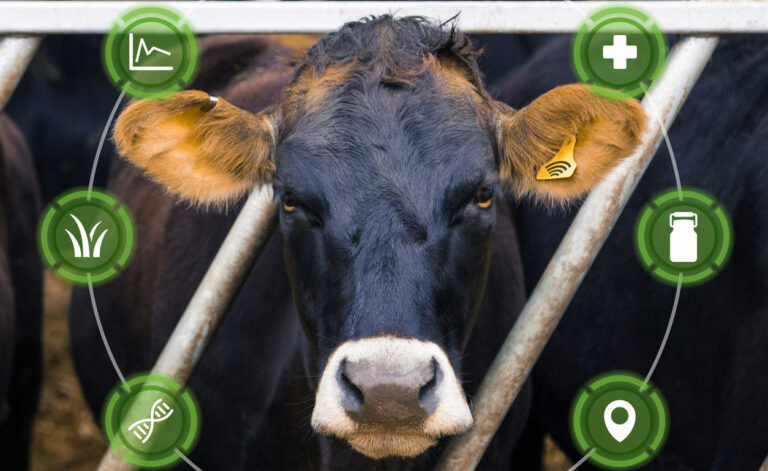Introduction
The increasing demand for food production and other livestock products due to population growth has led individuals in this field to seek ways to optimize efficiency and productivity in animal husbandry. One of these ways is to pay attention to climatic conditions and the adaptability and performance of different livestock breeds in these conditions. In this article, we first intend to examine the effects of different climatic conditions on milk production, growth, and reproduction of livestock. In the second section, after becoming familiar with these effects, we will discuss the prevalence of specific diseases in different environmental conditions. After reviewing several important phenomena in this section, we will move to the final section, where detailed explanations about various breeds of cattle and sheep will be provided. The goal of this article is to emphasize the importance of different environmental conditions on the productivity of livestock.
The Effects of Climate on the Performance of Livestock Breeds
Weather plays an important and often overlooked role in livestock productivity. The environment not only determines survival but also affects the growth, milk production, and reproduction of livestock. In this section, we will examine the mentioned factors to enhance awareness and insights for better performance.
1. Growth of Livestock in Different Climatic Conditions
The growth rate of livestock varies significantly with different weather conditions. Factors such as ambient temperature, relative humidity, and the physical geography of the land (e.g., type of terrain, availability of shade, etc.) greatly affect the animals’ ability to grow. In favorable climates, livestock expend less energy to maintain homeostasis[1] and can use more energy for growth. In harsh climates, additional energy is used to combat environmental stressors, which can disrupt the growth process and endanger the health of the animals.
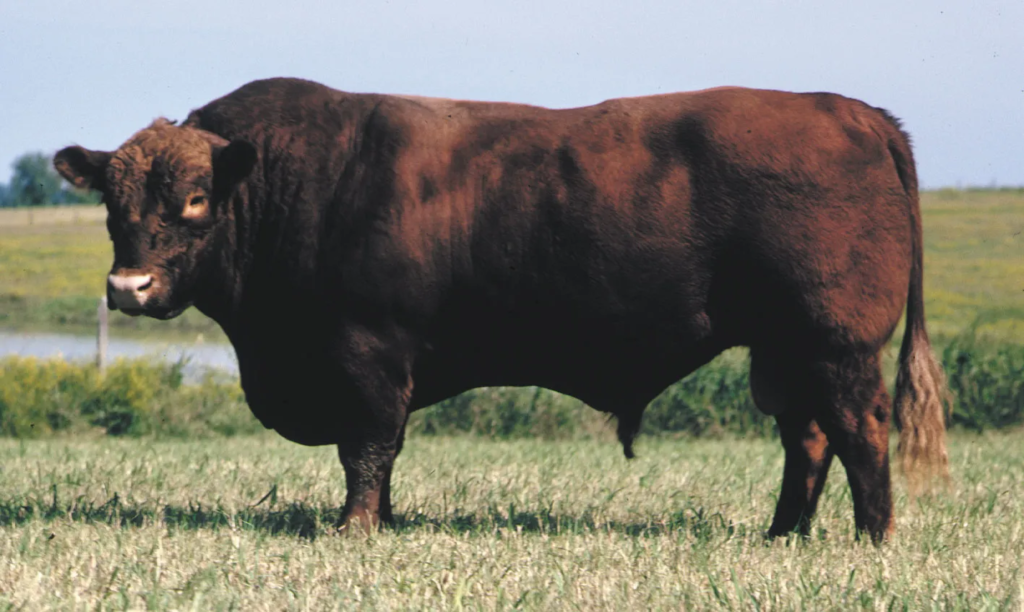
For example, in this section, we aim to examine the performance of the Angus cattle breed in dry climates and temperate climates.
The Angus cow is a breed known for its rapid growth and high-quality meat. They thrive in temperate climates, such as Scotland or the cooler regions of North America. The moderate climate and abundant forage allow these cattle to grow consistently and maintain healthy body conditions. Conversely, in dry areas like parts of Australia or the southwestern United States, the lack of quality forage slows their growth rate.
The following chart shows the growth rate of this breed in kilograms during the first 8 months of their life:

2. Milk Production of Livestock in Different Climatic Conditions
Milk production in dairy cows is highly dependent on climatic conditions. The optimal temperature for dairy breeds is between 5 to 25 degrees Celsius, beyond which milk production can begin to decrease. High temperatures and humidity can lead to heat stress, resulting in reduced feed intake, altered metabolism, and decreased milk secretion. Cooler climates generally allow for higher milk production due to less heat stress and better conditions. In this section, we will examine the milk production of the Holstein breed.

Holstein Friesian, the leading dairy breed in the world, performs optimally in cooler climates. These conditions lead to increased milk production with rich fat and protein content, ideal for dairy products. Conversely, in tropical climates, these cows can suffer from heat stress. This stress reduces milk production and affects the composition of the milk.
Dr. Emily Roberts, a dairy science specialist, explains: “High ambient temperatures significantly reduce milk synthesis in dairy cows. This reduction is not just quantitative but also qualitative, affecting essential milk components such as fats and proteins.” In animal physiology, managing heat stress through cooling systems and dietary adjustments is crucial for maintaining milk production in hot climates.
3. Reproduction and Climate Change
Today, with the increasing demand for meat, dairy, and other products, the reproduction rate of livestock has become highly significant. This aspect is significantly influenced by climate. Extreme temperatures, whether hot or cold, can affect the hormonal balance necessary for successful fertilization and pregnancy. Animals in cooler and more temperate climates tend to have higher fertility rates and healthier offspring due to more stable environmental conditions that support regular nutrition and reduced physiological stress.
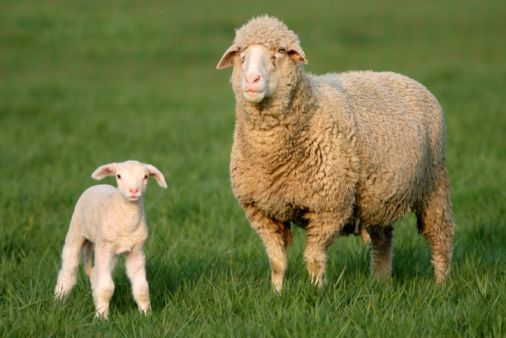
As in previous sections, here we will examine the reproduction rate of the Merino sheep breed in both cool and warm climates.
Merino sheep, renowned for their high-quality wool, exhibit significant variation in reproductive performance based on climate. In cooler climates, such as New Zealand and parts of Australia, Merinos experience high fertility rates and reduced lamb mortality. However, in warmer climates, heat stress can lead to reduced fertility and higher rates of early mortality among lambs.
The following chart shows the fertility rates and the survival percentage of Merino lambs in cold versus warm climates:
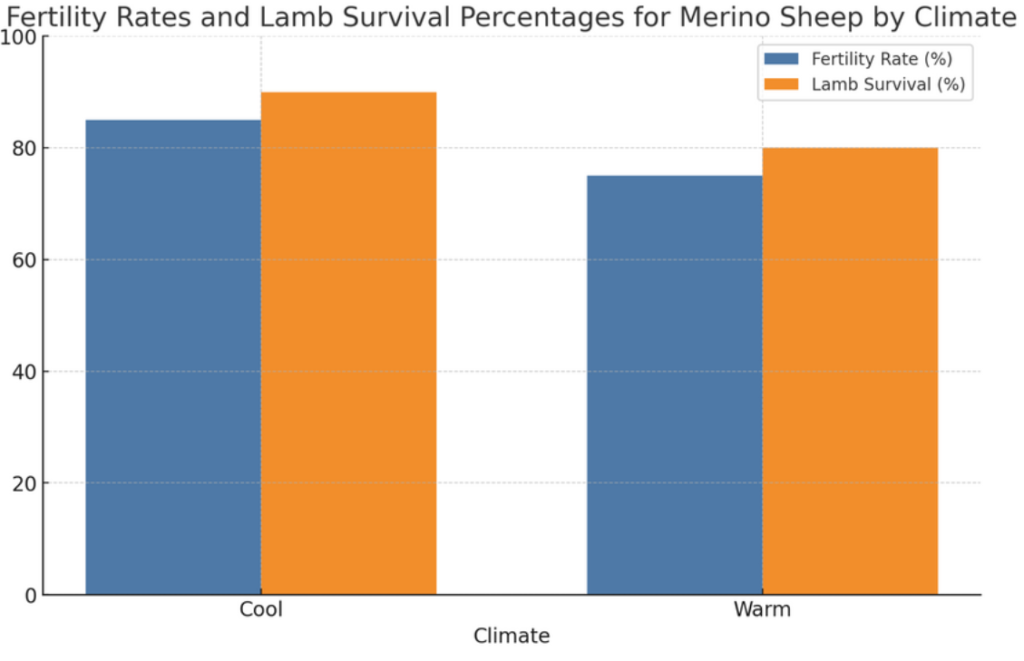
The effects of weather and different climatic conditions on the spread of certain diseases in livestock
Climate and climate change significantly affect the health and welfare of livestock. In this section, we will examine the role of climatic factors such as temperature, humidity, and seasonal changes in the spread and prevalence of livestock diseases.
1. Climate-Specific Diseases
In tropical and semi-tropical climates, temperatures often exceed 30 degrees Celsius with high humidity. This condition can lead to heat stress in livestock, resulting in reduced feed intake, decreased fertility, and increased susceptibility to diseases. The physiological effects include altered metabolic[2] rates, impaired immune system function, and increased oxidative[3] stress. Research shows that cattle exposed to chronic heat stress have higher rates of respiratory diseases compared to those in temperate regions.
To better understand, the following chart compares the incidence of respiratory diseases and mastitis[5] (Figure. 1) in livestock during the peak summer months versus the colder months.
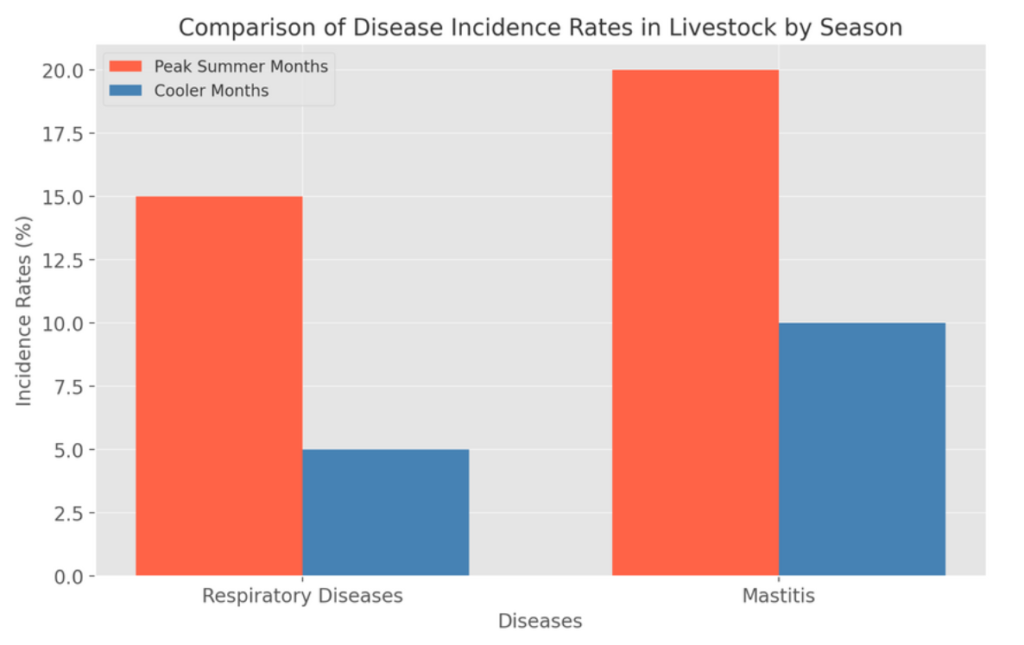

2. Vector-Borne Diseases in Livestock
Ticks thrive in warm and humid climates. Tick-borne diseases, such as Lyme disease[6] in sheep and Anaplasmosis[7] in cattle, are concerning. Pathogens[8] carried by ticks can affect the liver, heart, and spleen of livestock, leading to severe illness and even mortality. With the warming seasons due to climate change, ticks remain active throughout the year, increasing the incidence of these diseases.
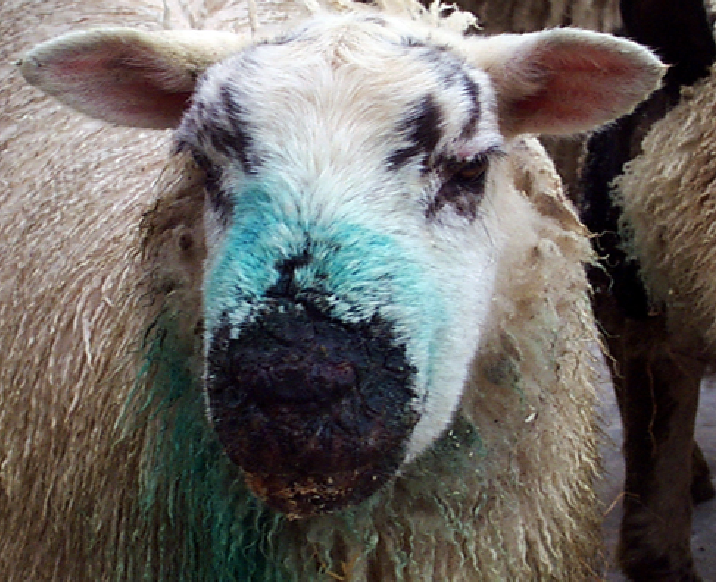
Lyme Disease in Sheep
Anaplasmosis
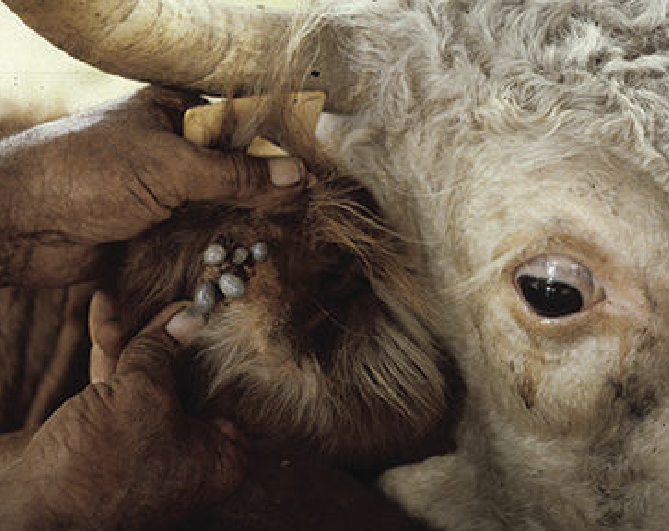
Dr. Johan Gustavsson, a veterinary parasitologist, states that the expansion of tick habitats due to global warming is an increasing threat to livestock health.
Expanding Range of Tick-Borne Pathogens in Northern Europe: A Climate Change Prediction,” European Journal of Epidemiology
3. The Impact of Climate Change on the Spread of Diseases in Livestock
Climate change affects not only environmental conditions but also the habitats of vectors and the life cycles of pathogens[8]. Increased rainfall and flooding can lead to higher incidences of waterborne diseases like Leptospirosis[9]. Drought conditions also concentrate animals and vectors around limited water sources, increasing contact rates and disease transmission. Studies show that prolonged drought conditions lead to more frequent outbreaks of Q fever[10], as livestock gather around scarce water sources, facilitating the spread of Coxiella Burnetii[11] among herds.
Detailed Examination of Various Cattle and Sheep Breeds
In the previous sections, we examined the impact of climate and climate change on the growth, milk production, and reproduction of livestock. We then studied the diseases that arise in different climatic conditions and threaten livestock health. Now, we will explore the characteristics, features, and advantages of various cattle and sheep breeds and determine which climates and weather conditions they perform best in.
Cattle Breeds
Holstein
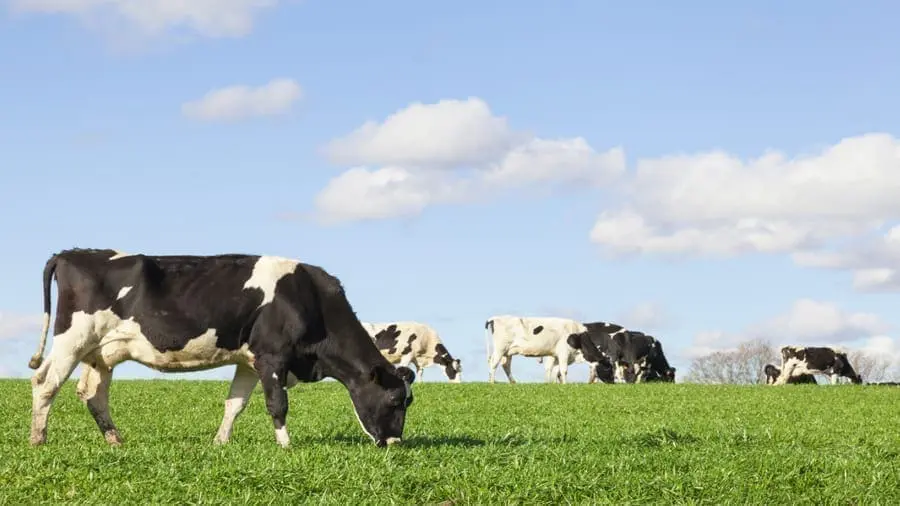
Holstein-Friesians, originating from the Netherlands and northern Germany, are globally renowned for their high-volume dairy production. Their genetic structure is precisely engineered for maximum milk production.
Characteristics of this breed: The most important feature of this breed is the large volume of milk production. Holstein-Friesians can produce an average of 23,000 pounds of milk per lactation cycle (the period between two calvings) with significant fat and protein content. They have a large build and a fast metabolism[2], which enhances their efficiency.
Advantages over other breeds: Their ability to produce a significantly higher amount of milk compared to other breeds makes them a cornerstone in the dairy industry, offering economies of scale and efficient production metrics.
Best environmental conditions for higher productivity: Research shows that Holstein-Friesians achieve optimal performance in controlled environments with moderate temperatures (5-25 degrees Celsius). Generally, the most crucial factor for higher productivity in this breed is protecting them from heat stress.
Jersey
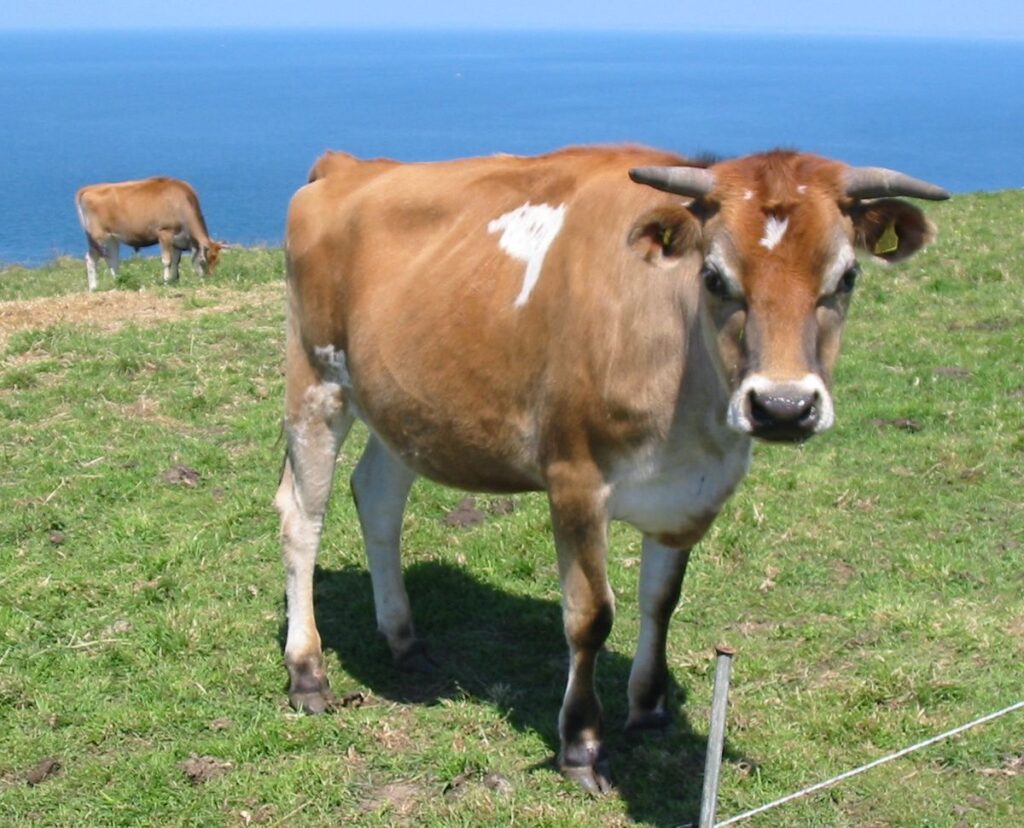
Jerseys, originating from the Jersey region, are much smaller than Holsteins and are noted for their high butterfat and protein content in milk, making them ideal for cheese production.
Characteristics: Jersey cows weigh between 800 to 1200 pounds, consuming less feed and occupying less space compared to other breeds like Holsteins. Their milk contains 6% butterfat, significantly higher than other breeds.
Advantages over other breeds: One of the most important advantages is the high butterfat content of their milk, which is crucial for dairy product manufacturing. Jerseys also perform better in heat tolerance compared to many dairy breeds, making them adaptable to various climatic conditions.
Best environmental conditions for higher productivity: Their physical structure and genetic profile make them suitable for maintenance in most climates. This breed is one of the few that can respond to and protect itself from heat stress, making it resilient against the associated risks.
Simmental
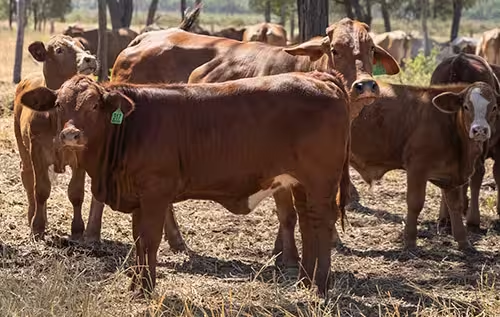
Simmentals, originating from Switzerland, are one of the oldest and most versatile cattle breeds, used for both meat and dairy production throughout Europe and North America.
Characteristics: Simmentals are large and muscular, known for their rapid growth and substantial body mass, with bulls weighing over 2800 pounds. They have a good balance of muscle and fat, making them suitable for dual-purpose use in milk and meat production.
Advantages over other breeds: The versatility of Simmentals is a major advantage, allowing farmers to switch between milk and meat production based on market conditions. They are also incredibly resilient and can thrive in diverse agricultural environments.
Best environmental conditions for higher productivity: Their thick skin and genetic adaptability make them suitable for colder climates, where they can use their natural insulation against the cold. However, they can also adapt to warmer climates, although this may reduce their productivity.
Sheep Breeds
Merino

Among sheep breeds, Merinos are renowned for the quality of their wool. Originating from Spain, Merinos have played a crucial role in the global wool industry, particularly in Australia, where they dominate the market.
Characteristics: Merinos are distinguished by their exceptional wool quality, characterized by fine fibers and high density, which is highly valued in the textile industry. Their adaptability to harsh climates is facilitated by body temperature regulation mechanisms, making their wool production ideal for luxurious fabrics.
Advantages over other breeds: The unmatched quality of Merino wool provides a premium product that supports a lucrative market. Their hardiness and adaptability reduce the need for extensive effort and intervention in managing this breed.
Best environmental conditions for higher productivity: While Merinos adapt to various climates, they thrive in dry and semi-arid environments, where their unique wool and physiological features maximize their survival and productivity.
Dorset

Dorsets originate from England and are known for their ability to breed out of season, making them a valuable breed for meat production. Dorsets are recognized for their ability to lamb throughout the year.
Characteristics: Dorsets are medium-sized sheep known for their quality meat and efficient reproduction. Their ability to breed year-round is a significant advantage for continuous meat production.
Advantages over other breeds: The year-round breeding capability of Dorsets is a genetic trait that allows flexibility in managing breeding programs to meet market demands. They also possess traits that lead to efficient meat production, such as good feed conversion ratios and carcass quality.
Best environmental conditions for higher productivity: Dorsets have the ability to adapt to various conditions. They perform well in cold and temperate climates. Their strong genetic structure makes them suitable for diverse agricultural environments, from pastures in temperate regions to more challenging areas.
Solutions Offered by Ansel Farm
At Ansel Farm, we deeply understand the significant impact of climate on livestock performance. Leveraging years of experience in agriculture and industry, we offer a range of solutions designed to optimize the health and productivity of livestock. Here are some key methods through which we can help improve livestock performance:
1. Climate-Controlled Facilities
Our advanced, climate-controlled facilities provide the appropriate environmental conditions for livestock, regardless of external weather conditions. By maintaining optimal temperature and humidity levels, we ensure that animals are comfortable and stress-free, leading to better growth rates and overall higher health.
2. Specialized Feeding Programs
Proper nutrition is crucial for livestock performance, and our specialized feeding programs are tailored to the specific needs of different breeds and climatic conditions. We use high-quality ingredients and advanced formulations to ensure that livestock receive all the essential nutrients necessary for growth, reproduction, and disease resistance.
3. Genetic Selection and Breeding
At Ansel Farm, we employ advanced genetic selection and breeding techniques to produce livestock with superior traits. By focusing on disease resistance, climate adaptability, and productivity, we help farmers breed animals that perform best in their specific environments.
4. Health Monitoring and Veterinary Services
Regular health monitoring and timely veterinary care are essential for maintaining livestock performance. Our team of experienced veterinarians provides comprehensive health check-ups, vaccinations, and treatments to prevent and effectively manage diseases.
5. Sustainable Farming Practices
We advocate for sustainable farming practices that not only benefit the environment but also improve livestock performance. Practices such as rotational grazing, proper waste management, and the use of renewable energy sources help maintain a healthy ecosystem and reduce the risk of disease outbreaks.
6. Training and Support
We believe in empowering farmers with the knowledge and skills needed for success. Our training programs cover a wide range of topics, including animal husbandry, disease management, and the latest advancements in agricultural technology. Additionally, our advisory service team is always ready to provide the necessary guidance and support.
Conclusion
Today, due to population growth and phenomena like global warming, great care must be taken to optimize the livestock industry. In this article, we began by examining the impacts of climatic conditions on the performance of various livestock breeds. We then discussed the factor of dangerous diseases resulting from different environmental conditions, and in the final section, we reviewed several cattle and sheep breeds.
Ansel Farm, in addition to its activities in agriculture, is also ready to serve livestock farmers by providing the latest services in the livestock sector. The main goal of Ansel Farm is to identify and solve problems in the fields of agriculture and livestock, and to discover the necessary solutions.
Glossary
1. Homeostasis: A process in which living organisms maintain a stable internal environment despite external changes, ensuring optimal function and survival.
2. Metabolism: Refers to the chemical processes in living organisms that convert food into energy, supporting growth, reproduction, and the maintenance of bodily functions.
3. Metabolic: Pertains to the biochemical processes that occur in living organisms to sustain life, including energy production, growth, and waste elimination.
4. Oxidative: Oxidative stress is a condition characterized by an imbalance between free radicals and antioxidants in the body, leading to cellular and tissue damage.
5. Mastitis: Mastitis is an infection of the mammary gland, commonly occurring in dairy animals such as cows and goats, leading to inflammation of the udders and potentially affecting milk production.
6. Lyme Disease: Lyme disease is a bacterial infection transmitted by ticks, affecting sheep as well as other animals and humans, characterized by fever, lameness, and joint swelling.
7. Anaplasmosis: An infectious disease caused by bacteria of the genus Anaplasma, transmitted by ticks, affecting red blood cells in animals like cattle and sheep, leading to severe anemia.
8. Pathogen: A pathogen is any living organism that can cause disease, including bacteria, viruses, fungi, or parasites.
9. Leptospirosis: A bacterial infection caused by Leptospira bacteria, affecting many animals and humans, leading to kidney damage, liver failure, and sometimes death.
10. Q Fever: An infectious disease caused by the bacterium Coxiella burnetii, affecting humans and animals, with symptoms like high fever, severe headache, and muscle pain.
11. Coxiella burnetii: The bacterium responsible for causing Q fever, primarily affecting livestock such as cattle, sheep, and goats, and can be transmitted to humans mainly through inhalation of contaminated materials.


